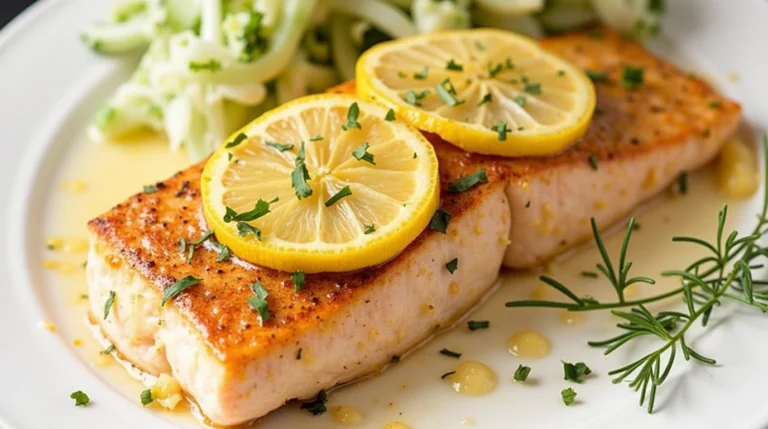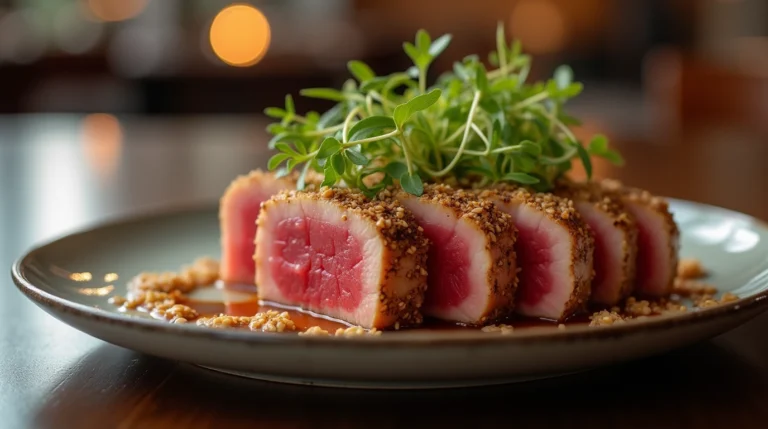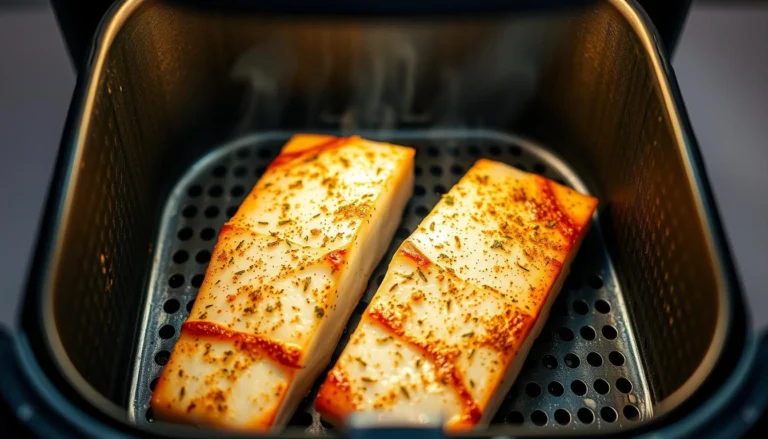Master the Art of Smoked Fish: 7 Steps to a Flavorful Brine
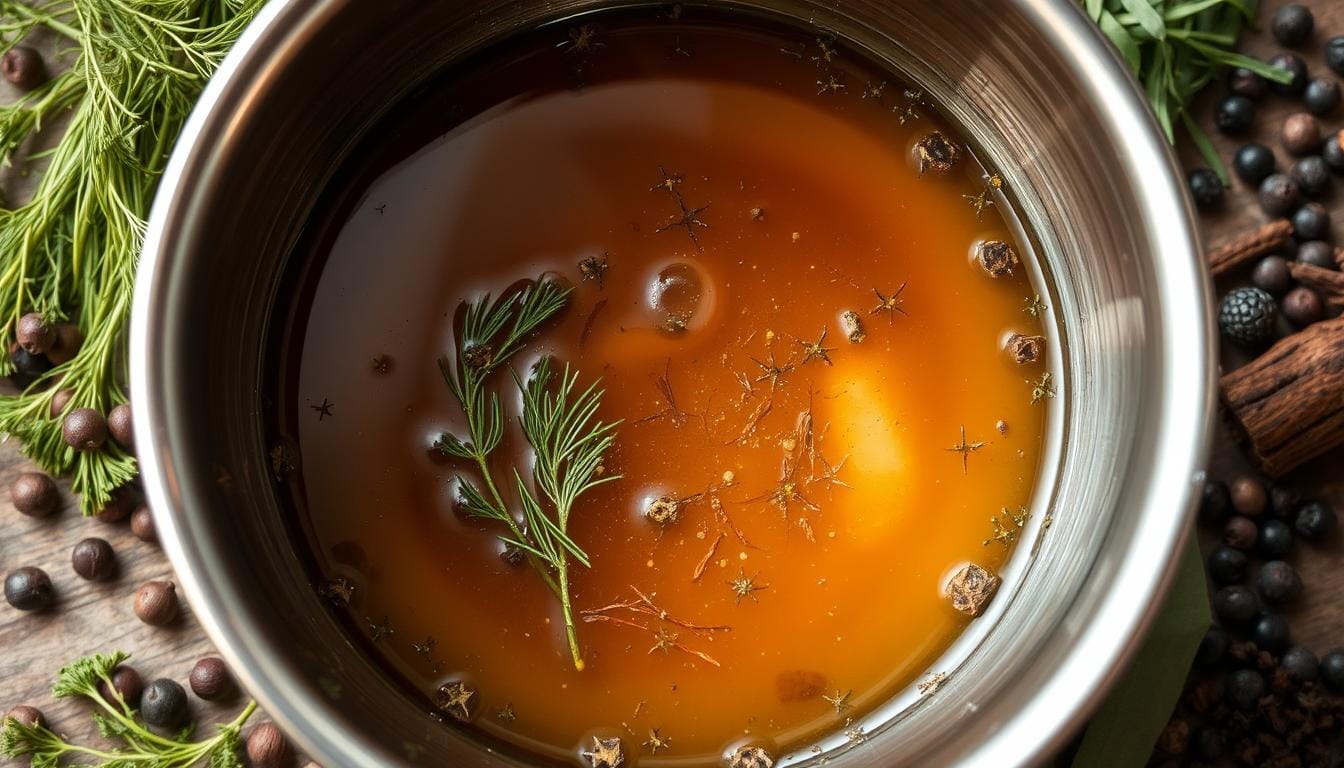
Table of Contents
The smell of smoked fish reminds me of my grandfather’s kitchen. It was where simple ingredients became amazing meals. In the Pacific Northwest, I learned that brining is key to making smoked fish special.
Brining is more than a way to prepare fish. It’s a tradition that makes seafood even better. Whether you cook at home or love trying new recipes, learning to brine can make your kitchen smell like a gourmet smokehouse. The right brine keeps your fish juicy and full of flavor.
Knowing how brining works is important. It helps fish soak up flavors and keeps it moist during smoking. With the right brine, your smoked fish will taste like something from a fancy market.
Key Takeaways
- Brining is essential for creating flavorful and moist smoked fish
- Proper brining time ranges from 45 to 90 minutes
- The right salt-to-sugar ratio is critical for optimal flavor
- Brining helps preserve fish and enhance its natural taste
- Different fish types require slightly varied brining techniques
Understanding the Art of Fish Smoking and Preservation
Fish smoking is an old cooking method that turns regular seafood into a tasty treat that lasts longer. It has been around for thousands of years. Our ancestors found out that smoke can protect and make food better.
Smoking fish is a mix of science and tradition. It involves controlling temperature, moisture, and smoke to make seafood that tastes great and lasts a long time.
Historical Roots of Fish Smoking
Smoking fish was key for people living by the sea or rivers. Before we had refrigerators, they needed ways to keep food from spoiling fast. Smoking was a smart way to:
- Stop bacteria from growing
- Keep nutrients in the food
- Make food taste better
- Keep food fresh longer
Scientific Principles of Fish Preservation
Salt curing is crucial in smoking fish. It pulls out moisture and makes a place where bacteria can’t grow. This science is about:
- Lowering water activity
- Stopping microorganisms from growing
- Making flavors stronger
Modern Smoking Techniques
Today’s smoking methods have changed a lot. We now use everything from old wood-fired smokers to new electric ones. Experts control:
- Temperature (120°F to 180°F for hot smoking)
- How thick the smoke is
- How wet or dry the fish is
- How to cure the fish
“Smoking fish is an art form that bridges ancient preservation techniques with modern culinary innovation.” – Seafood Preservation Expert
Whether you’re cooking at home or in a restaurant, learning about smoking fish can improve your seafood skills. Each method gives different tastes and ways to keep food fresh.
Essential Ingredients for the Perfect Smoked Fish Brine
Making a tasty brine solution is key to making your smoked fish amazing. The right mix of ingredients turns a simple fillet into a flavorful treat. It will wow even the pickiest seafood lovers.
Your brine needs a few important parts to boost flavor and keep the fish fresh. Here are the must-haves:
- Salt: Salt is the base, drawing moisture and protecting the fish
- Brown Sugar: It adds sweetness and gives the fish a golden color
- Water: It’s the liquid base for mixing other ingredients
- Smoke flavoring enhancers like herbs and spices
A basic brine recipe for about 10 pounds of fish fillets includes:
- 1 gallon water
- 2 cups brown sugar
- 2 cups table salt
To make your brine special, try adding unique flavors with:
- Chili peppers
- Wasabi
- Soy sauce
- Worcestershire sauce
- Lemon juice and zest
- Whole peppercorns
Playing with these ingredients lets you craft a brine that shows off your cooking style. The goal is to find the right balance of salt, sugar, and water. This will make your fish taste even better.
Selecting the Right Fish for Smoking
Choosing the perfect fish is key to making delicious cured seafood. Not all fish are good for smoking. Knowing the differences can make your fish curing better.
Your success in smoking fish depends on picking the right types. Some fish are better for smoking because of their special qualities.
Best Fish Varieties for Smoking
- Salmon: The king of smoked fish, with rich oils that absorb smoke beautifully
- Trout: Delicate flavor that pairs wonderfully with gentle smoke
- Mackerel: Oily fish that develops deep, complex flavors when smoked
- Cod: Mild-flavored white fish that takes on smoke exceptionally well
Quality Indicators When Choosing Fish
When picking fish for smoking, look for these key quality indicators:
- Fresh, bright eyes
- Firm, elastic flesh
- Clean, ocean-like smell
- No discoloration or browning
Fat Content Considerations
| Fish Type | Fat Content | Smoking Time |
|---|---|---|
| Salmon | High | 1.5-2 hours |
| Trout | Medium | 1-1.5 hours |
| Cod | Low | 1-2 hours |
Fat content is very important in smoking. Oily fish like salmon soak up smoke well and taste richer. Leaner fish need more care to avoid drying out.
Pro tip: Always choose the freshest fish possible for the best smoking results.
The Ultimate Smoked Fish Brine Recipe
Making the perfect smoked salmon brine is an art. It turns regular fish into a tasty treat. Your brine solution adds rich flavors and keeps the fish moist and tender.
To make an amazing smoked salmon brine, you’ll need these ingredients:
- 4 cups water
- 1/2 cup kosher salt
- 1/2 cup brown sugar
- 1 tablespoon black peppercorns
- 1 tablespoon whole cloves
- 1 bay leaf
- 2 minced garlic cloves
- Juice of 1 lemon
- 1 tablespoon dried thyme
- 1 tablespoon dried dill
The secret to a great smoked salmon brine is finding the right balance. Each ingredient is important for flavor depth. Salt keeps the fish fresh, and brown sugar adds a sweet touch that caramelizes when smoked.
Here are some pro tips for making your brine:
- Dissolve salt and sugar in warm water
- Let the brine cool before adding fish
- Make sure fish is fully covered in brine
- Keep it refrigerated during brining
Brine the salmon for 8-12 hours. This lets it soak up lots of flavor without getting too salty. After brining, rinse and pat dry the fish. Let it dry before smoking.
Preparing Your Fish for the Brining Process
Starting your fish curing journey requires careful preparation. First, choose high-quality fish and make sure it’s ready for brining. Cleaning and handling the fish correctly are key to making delicious smoked fish.
Essential Cleaning Techniques
Before you start brining, clean your fish well. This means removing scales, bones, and any dirt. Here are the main steps for effective fish curing:
- Rinse the fish under cold water
- Remove all internal organs carefully
- Pat dry with clean paper towels
- Trim any unwanted fatty sections
Temperature Management
Temperature is very important in preserving fish. Keep your fish at a safe temperature to stop bacteria from growing during curing.
| Stage | Recommended Temperature | Purpose |
|---|---|---|
| Cleaning | Below 40°F | Prevent bacterial development |
| Brining | 38-40°F | Ensure safe salt absorption |
| Pre-smoking Rest | 40-50°F | Develop pellicle |
Timing Guidelines for Brining
The brining time varies based on the fish’s thickness and type. Smaller fillets need less time, while thicker ones require more salt exposure:
- Thin fish fillets (under 1 inch): 30-45 minutes
- Medium fish fillets (1-2 inches): 1-2 hours
- Thick fish cuts (over 2 inches): 2-4 hours
After brining, rinse your fish in cold water to remove extra salt. Dry it well and let it air-dry for an hour. This step helps the smoke stick better during smoking.
Creating the Perfect Pellicle After Brining
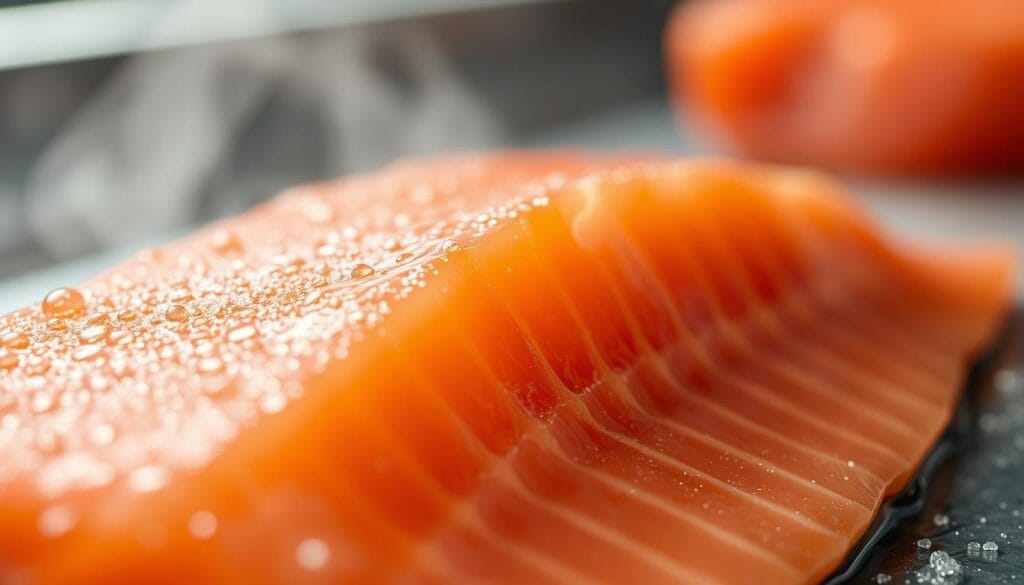
Creating a pellicle is key in fish curing. It turns your smoked fish into something amazing. A pellicle is a sticky layer on the fish’s surface. It holds smoke particles and boosts flavor.
The process of making a pellicle is important. You need to pay close attention. Here are the main steps:
- Pat the brined fish completely dry with paper towels
- Place the fish on a rack in a cool, well-ventilated area
- Allow the fish to air dry for 30 minutes to 8 hours
- Maintain temperature below 65°F for optimal results
As the fish dries, its surface will get sticky and shiny. This is crucial for soaking up smoke. The drying time depends on the fish and the environment. It usually takes 30 minutes to 4 hours for most seafood.
Pro tip: A well-formed pellicle ensures your smoked fish develops a rich, even color and intense smoky flavor.
Commercial smokers use special cooling rooms. But, home cooks can get great results with a fridge or a cool, breezy spot. The trick is to be patient and keep the right conditions during curing.
Wood Selection and Smoking Techniques
Mastering the smoking process is all about choosing the right wood and how to smoke it. The wood you pick can change the taste and smell of smoked fish. It can turn a simple dish into a work of art.
Best Woods for Fish Smoking
Each wood type brings its own flavor that goes well with different fish. The wood you choose affects the smoke flavor of the fish.
- Alder Wood: Ideal for salmon, trout, and shrimp with a sweet, mild flavor
- Applewood: Perfect for white fish, adding a subtle fruity sweetness
- Cherry Wood: Provides a sweet and slightly tart flavor for salmon and sturgeon
- Maple Wood: Complements oily fish with a rich, sweet undertone
- Hickory: Best for robust fish like tuna and mackerel, offering bold smoky notes
Temperature Control Methods
Keeping the temperature just right is key in smoking. Hot smoking is between 175°F and 200°F. Cold smoking is below 90°F.
| Smoking Type | Temperature Range | Typical Duration |
|---|---|---|
| Hot Smoking | 175°F – 200°F | 2-3 hours |
| Cold Smoking | Below 90°F | 12-18 hours |
Smoking Duration Guidelines
The time you smoke fish depends on its type, size, and how smoky you want it. Always check the fish’s internal temperature reaches 145°F for safety.
Pro tip: Soak wood chips in water, apple cider, or wine for 12-24 hours. This helps prevent them from burning too fast and ensures a flavorful smoke.
Common Mistakes to Avoid When Brining Fish
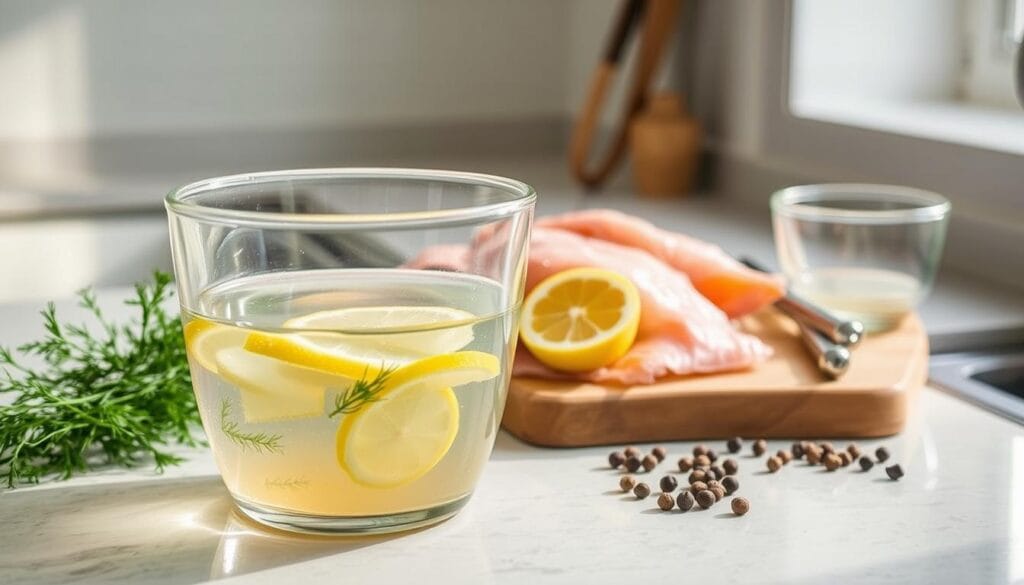
Brining fish is an art that needs precision and detail. Many home cooks make big mistakes during the fish preservation process. These mistakes can ruin the quality and safety of their smoked fish.
When curing fish, several common pitfalls can ruin your smoking efforts:
- Over-brining: Leaving fish in brine too long can make it too salty
- Inconsistent brining times that fail to properly preserve the fish
- Neglecting temperature control during the brining process
- Using incorrect salt-to-water ratios
Temperature management is key in fish preservation. Your brine solution should be between 34-40°F to stop bacterial growth. Most fish need 3-6 hours in brine, with thicker fillets needing up to 8 hours.
Smoking technique is also very important. Uneven smoking can be fixed by:
- Rotating fish during the smoking process
- Maintaining a steady temperature inside the smoker
- Monitoring smoke intensity
- Checking fish at regular intervals
The CDC says only 6% of food-borne illnesses come from seafood. But, proper handling during brining and smoking can lower these risks. By avoiding these common mistakes, you’ll get a delicious and safe smoked fish experience.
Storage and Serving Suggestions
Keeping your smoked fish fresh is key. After smoking, you want it to stay tasty and safe. Follow these steps to keep your fish in top shape.
For the best storage, remember these tips:
- Refrigerate smoked fish within 3 hours of purchase
- Store in airtight containers or vacuum-sealed bags
- Keep refrigerated at 40°F or below
- Consume opened smoked fish within 5 days
Freezing is great for long-term storage of smoked fish. Freezing vacuum-sealed fish can keep it good for up to 3 months. When you thaw, give it 24 hours in the fridge.
Here are some ways to serve your smoked fish:
- Create elegant appetizers on crackers or crostini
- Incorporate into salads for added protein
- Use as a topping for bagels with cream cheese
- Fold into scrambled eggs or omelets
Different smoked fish types need different storage. Cold-smoked fish has different needs than hot-smoked. Always check the package for the best storage advice.
Conclusion
Your journey into smoked fish brine is more than a cooking skill. It’s about exploring flavors, keeping food fresh, and honoring traditions. The smoking process turns regular fish into a special treat. Each step is designed to boost taste and keep food fresh longer.
Learning about smoked fish brine takes time and effort. You’ll need to pick the right fish and get your brining just right. Smoking fish is both a science and an art. The cold-smoking method keeps fish fresh while adding deep, rich flavors to your dishes.
As you try out different wood chips, brine levels, and fish types, you’ll grow to love this old method. It’s amazing how it used to cut down fish waste, once up to 70 percent. Now, it turns simple ingredients into tasty, lasting meals.
See smoking fish as a way to be creative in the kitchen. Your smoked fish brine is more than a recipe. It connects you to a long line of food preservation traditions that still excite people everywhere.

